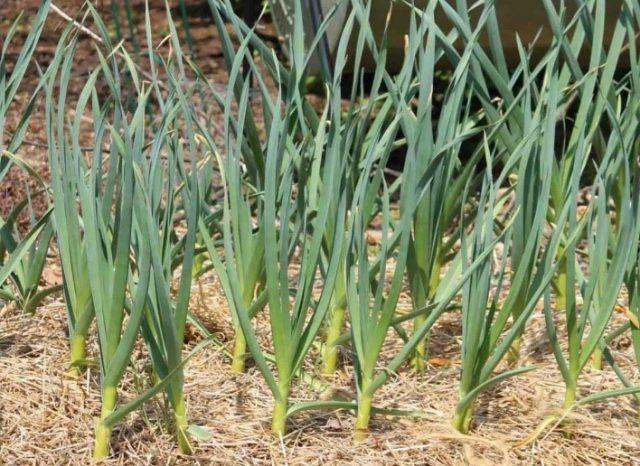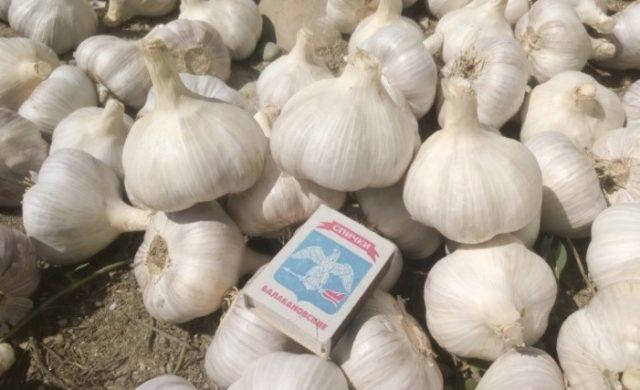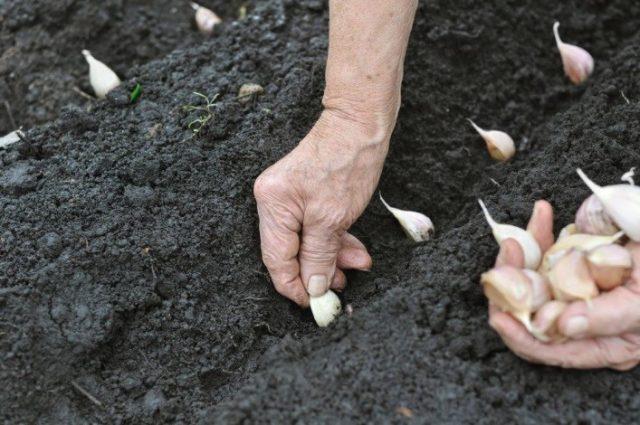Contents
Spring varieties of garlic are valued for the fact that, if planted in spring, by the end of summer, the heads fully ripen and, as a rule, are subject to long-term storage. For cultivation, it is important to choose high-yielding and disease-resistant species. Garlic Gulliver is distinguished by massive bulbs with large teeth and immunity to infections and pests.

Garlic variety Gulliver is undemanding to weather conditions and soil composition
History of breeding
The Gulliver garlic variety was bred in Our Country, but, by all accounts, the taste and other consumer qualities of the product meet international standards. The originator of the culture is the Federal Scientific Center for Vegetable Growing, located in the Moscow region. The garden plant is perfectly adapted to climate conditions, ranging from the subtropics to the northern regions of the temperate zone.
Description of the variety of garlic Gulliver
Garlic Gulliver is included in the category of spring, arrow varieties. A mature vegetable crop has 8-12 feather sheets of saturated green color, 50-60 cm long. A distinctive quality is a dense wax coating on feathers. Rounded heads are large, embossed, weighing from 90 to 300 g, with teeth of white or gray-lilac color.
Palatability
The Gulliver variety has a traditionally sharp, vigorous taste. The white pulp of the cloves is dense, juicy. The bulb exudes a pronounced garlic aroma.
Ripening and yield
Garlic Gulliver belongs to the category of medium-late varieties. The vegetation period of the plant is 87-98 days. The yield reaches 1 kg of bulbs per 1 m2. The collected product is stored for up to eight months.
Disease resistance
Gardeners note the special resistance of the Gulliver variety to diseases, subject to the rules of agricultural technology.
Over-watering and damp weather can lead to the development of a fungal infection:
- white rot;
- black mold;
- powdery mildew.
The main preventive measure is to prevent overcrowding of plantings. In June, it is recommended to thin out the beds if the heads are very large. In early July, it is advisable to fertilize with ammonium sulfate. The following drugs are used as fungicides:
- Phytosporin;
- Bitoxibacillin;
- Gamair-T.
Garden crops under adverse conditions may be subject to insect invasion. The main pests of the plant are:
- stem nematode;
- onion fly;
- root mite;
- thrips.
Most often, young shoots suffer from stem nematodes. In order to protect against a pest that mercilessly destroys a plant, calendula or chicory are planted next to the garden bed.
Growing regions
Garlic Gulliver has a high level of endurance. The variety is used for planting in most regions and neighboring countries. The species grows equally well and produces an excellent harvest in private gardens and extensive farms.
Advantages and disadvantages
Large heads with rather large cloves are the quality of a vegetable crop, which is considered the most valuable among farmers and consumers.

The originators note that the Gulliver garlic variety is distinguished by high and stable yields.
Pros:
- stable immunity to diseases;
- excellent product characteristics;
- good keeping quality;
- frost resistance.
Cons:
- Strict observance of the rules of agricultural technology in cultivation and care is required.
Rules of landing
Properly organized and timely planting is a prerequisite for obtaining an early harvest. Garlic Gulliver is recommended to be planted in early spring. In central Our Country, this time falls on the beginning of April, in the southern regions garlic can be planted as early as March, in the northern regions – in early May.
An important factor is the determination of the place for cultivation. It is preferable to choose a bright area with good drainage. Loamy or humus-rich soils are suitable for growing vegetables. It is advisable to carry out preliminary preparation of the land (loosening and fertilizing) in the fall. Then in the spring the soil will be softer and more nutritious.
Mineral complexes, organic substances should be used as top dressing. The optimal composition of fertilizer for garlic:
- humus – 5 kg;
- superphosphate – 20 g (tablespoon);
- potassium chloride – 15 g.
With a pH shifted to the “acidic” side, the earth must be treated with dolomite flour, chalk powder or slaked lime. At the end of soil preparation, garlic is planted.
The work algorithm is as follows:
- Large cloves are sorted from small ones, as they differ in growth rate.
- Soak garlic cloves in potassium permanganate or a solution of a biostimulating substance.
- Planted at a distance of 8 cm from each other, 25 cm – between the beds. The recommended embedment depth is 5-8 cm.
At the end of planting work, the bed should be mulched with peat or agrofibre. The protective layer helps retain moisture in the soil and reduces the number of weeds.

Warming up the earth to a temperature of +5 0С is a necessary condition for planting the Gulliver variety
Care instructions
Properly organized care guarantees an excellent harvest. Throughout the growing season, it is important to perform the following agricultural procedures:
- The organization of abundant watering during the active growth of greenery. With the advent of the sixth sheet, the frequency of procedures is reduced.
- Loosening the soil the next day after watering.
- Feeding after the appearance of feathers.
- Preventive treatment with fungicides.
July is harvest time. The harvested garlic Gulliver is sorted, dried and sorted according to the size of the heads. A dry, cool place is suitable for keeping the bulbs.
Features of the variety, growing and storage conditions are presented in:
Conclusion
Garlic Gulliver has high taste characteristics. In terms of consumer qualities, the product is comparable to the best varieties of the Dutch selection. Compliance with the rules of agricultural technology allows you to get an excellent harvest of vegetable crops when grown in different climatic zones.









